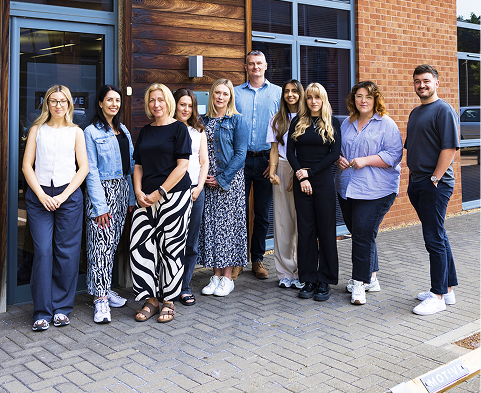A strong PR campaign is rarely built on big ideas alone – it’s held together by the everyday engine that keeps momentum going. And for many brands, that engine is the press office. But despite its importance, this side of PR often sits quietly in the background, overlooked in favour of headline-grabbing press releases or eye-catching creative campaigns.

Yet the press office is where trust is built. It’s the first touchpoint for journalists looking for comment and expertise. When it runs smoothly, it protects a brand’s reputation and keeps a steady flow of opportunities coming through. At Motive, we’ve managed press offices that increase visibility, shape public perception, and spark meaningful conversations around the brands we represent for many years. In this blog, we break down what makes a press office truly effective and why every successful PR strategy needs one.
What’s in this article:
- What is a press office?
- How to set up and run a press office
- How do press offices support AI search?
- Key takeaways
What is a press office?
A press office is multi-functional in a PR environment. It serves as the first port of call for journalists seeking a quote for a breaking news story, an image to accompany an article, a product for a gift guide, a sample to review, or an expert to feature on TV, radio, or a podcast.
For a brand, an active press office ensures reactive enquiries are handled efficiently, deadlines are met, and expectations are exceeded. Beyond this, regular exposure through these channels helps build trust in the company, its products, and services. This trust is crucial not only for reputation management but also for emerging digital spaces such as AI search, where credibility and trust signals are increasingly valued.
The question is, how do you go about setting up and running an efficient press office?
How to set up and run a press office
The key skills, beyond a solid understanding of your brand and the media landscape, are organisation and the ability to work under pressure. Deadlines are often tight, and the stakes can be high – if you overpromise and underdeliver, a journalist may not come back a second time!
Be responsive
When a journalist contacts you with a request, respond as swiftly as you can and make sure you understand what they’re asking. Journalists work in highly pressured environments. Acknowledging you’ve seen the request and are on the case with getting them what they need is the least you can do. Failure to respond may mean they find another expert or brand well placed to fulfill the request.
If you’re unable to help, don’t be afraid to say so. Keeping a journalist hanging wastes precious time. Honesty and transparency goes a long way in cementing a relationship with a journalist or media publication.
Ask questions
Ensure you understand the request. Think about it from your point of view as the PR person responding but also from the perspective of the brand or business you’re representing. What do you need to know to fulfil the request? Here’s some of the important information you’ll probably need:
.jpg)
- Clarify the request if you’re unsure - it’s better to ask the question at the outset rather than plough through and provide irrelevant information. It may determine whether or not you’re able to help and whether it’s the right opportunity for the brand.
- Deadlines - be clear on the deadline. If it’s within a few hours and you know your spokespeople are unavailable or it will be impossible to get comments approved, then be honest about it.
- Where it will appear - if the request is from a freelancer or a journalist who works across multiple platforms, don’t be afraid to ask where it will appear. It’s the first thing a client or senior leader within a business will want to know.
- Links - if your campaign is still link driven, then it’s worth asking the question. However, bear in mind that brand mentions in reputable media organisations are vital in AI search too. This may be a point you need to be clear on with the team you represent.
Meeting deadlines
As we’ve already mentioned, being clear on deadlines is essential. If you know you won’t be able to meet one, let the journalist know upfront. If your input is essential to the piece they’re working on, they may be able to extend the deadline. Honesty from the outset builds trust and keeps relationships strong.
When a deadline is tight, factor in the time it will take to prepare a comment, source an image, arrange and brief a spokesperson for a media interview, or even get them to a TV or radio studio. If the journalist is expecting a product for review, ensure you allow enough time for it to reach them to review it before the piece goes live.
For written comments that require sign-off, check whether the necessary person or team is available and whether you have enough time to get approvals. Clarifying all of this before you begin your response helps prevent last minute stress.
If delays do arise in signing off, sending final materials, or getting a product to a journalist, keep them informed – transparent communication is always better than leaving them guessing!
Types of enquiry
A press office can receive a multitude of enquiries. Below we’ve listed some of them and how to manage the enquiry and your response.
Comment
This can be in response to a rolling news story, to accompany a lifestyle piece within a print or online publication or a more in depth thought leadership piece for a niche publication. The same rules apply for all of these – be clear on the request, clarify the deadline, and put your response together.
If your comment is for a rolling news story, make sure you’re fully up to speed with the topic and where the news agenda will likely take the story next. You need to be relevant and move the story on. Deadlines on a news story will be tight. Be prepared for deadlines within hours, or even minutes! If you’ve been organised enough to anticipate enquiries, it’s worth having an outline ready so only minor adjustments will need to be made.
For lifestyle publications and niche titles, deadlines will be more generous, although there can be last minute pushes for comment. But again, don’t rest on your laurels. Get your response drafted, approved and over to the title as soon as it's ready. If you can submit well before the deadline, then do.
Image
If a media outlet is after an image, clarify exactly what they want. If it’s a headshot, does it need to be formal or informal? And does it need a white background? Similar for product shots – does the journalist require a cut out or a lifestyle image?
Check the size of the image too. High resolution is a given but for gift guides and specific image led pieces, journalists may require certain dimensions. Make sure the image fits exactly what they’re asking for. Fail to do this and your shot may not be included.
Label the image with your brand and product name to make it easy for them to retrieve. For a product led feature there will be lots of images flying around so make sure your’s is easy to locate.
Product
If the request to your press office is for a product then there’s a different set of information you’ll need. Clarify the product, when the journalist needs it by and then find out delivery details. An address, phone number and any delivery details including places to leave if they’re not in and if the address is tricky to find, any details the driver may need to find it.
Once you have the delivery date, confirm with the journalist and follow up post delivery to check it’s all received and as they were expecting.
TV / Radio
Broadcast opportunities need handling a bit differently and be aware these can be changed or even cancelled at just a moment's notice. There are certain bits of information you’ll need:
- When is the piece planned for?
- Will it be live or pre-recorded?
- Will you need the interviewee in the studio or on the phone?
- How long should they allow for the interview? This is particularly important if it’s a live interview via phone. The interviewee will need to be somewhere quiet and away from distractions.
- If it’s live in the studio, what time do they need to be there and who should they ask for on arrival?
While these may seem obvious questions, it’s important you get answers to put you and the interviewee at ease. Broadcast interviews can be daunting so doing everything you can to make sure it’s as stress free as possible will make it a much easier experience.
Following up
Do follow up to make sure the journalist has received everything they need from you and the brand you’re representing. And a thank you goes a long way once coverage appears!
.jpg)
Crisis management
The press office function is often the first point of contact in the event of a crisis. Managing the communications around any potentially negative and damaging event is vital to limit reputational damage.
The press office acts as the main point of contact for all communications and helps manage the flow of information. Timely messaging helps you stay in control of the story, rather than being on the back foot.
For journalists, having a single, trusted contact who is honest and transparent makes their job much easier – and helps ensure coverage is accurate and fair.
How do press offices support AI search?
AI search relies on trusted and authoritative information which is where high authority media sites come into their own – and where a fully functioning press office becomes an essential tool for PR practitioners.
AI search engines aim to give reliable answers and rely on signals of authority. High ranking media sites including the BBC, Bloomberg, The Guardian for example, are known and credible news sources. An AI summary is likely to cite these, making them important for your brand.
Responding to media enquiries in a timely manner through your press office will cement relationships with journalists and support the likelihood of appearing in AI search.
Key takeaways
- A functioning press office is central to managing media relationships and reputation. A good press office will be the main point of contact between a brand and a journalist handling a multitude of requests. A trusted press office delivering timely responses will only strengthen a brand's reputation.
- Transparency and organisation are key. A good press office will be well organised to enable it to meet tight deadlines. Transparency is important too – be honest if you’re unable to meet a deadline or fulfil a response.
- Efficiency equals increased requests and coverage. A press office able to deliver will become a trusted source of information for a journalist. It’s a great position to be in with press coming directly to you.
- Media coverage from trusted media sites support AI search visibility. AI search engines will prioritise information from high authority media sites. Mentions in these via press office requests strengthens a brand's authority signals.
- A press office protects a brand. At times of crisis, a press office is central in minimising reputational and ensuring consistency in messaging. In normal times, the press office will amplify a brand.
If your brand needs press office support to build reputation and increase coverage, speak to our PR team.



.jpg)

.jpg)
.jpg)
.jpg)



